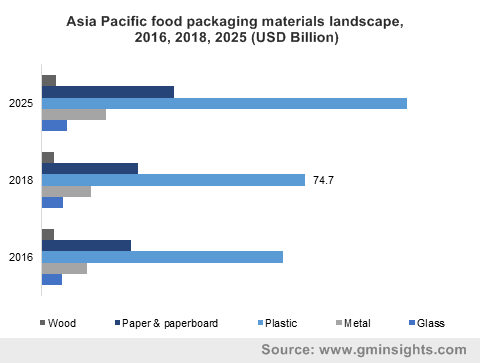APAC Food Packaging Market size to exceed $170 bn by 2025
Published Date: November 2019
Asia Pacific Food Packaging Market size is estimated to cross USD 170 billion by 2025; according to a new research report by Global Market Insights Inc.
The key application area of packaging is found to be in food & beverages, dairy products segment. With increasing demand in these sectors, food packaging market is also expected to rise in the upcoming years. The demand of packaged products is driven by shift in consumers preferences towards safe & hygienic packaging of ready to eat edible items. The significant milk production in Asian countries will lead to expansion in milk & dairy products and will boost entire APAC food packaging industry.
Attractive packaging and health benefits to drive consumption of packaged food
Rising urbanization and trend toward a busy lifestyle in emerging economies including India, China, and Korea will increase the product demand for convenient food habits owing to easy preparation and ready-to-eat nature of many meals. In addition to this, packaged foods, such as edible flakes, not only possess healthy and nutrition rich nature but are also easy to cook, making them suitable options for a healthy meal in the fast changing lifecycle.
Food packaging also increases the shelf life of the product and with rising trend toward healthy & nutritious eating habits such as all-natural, no added, and free from specific types that are prominently displayed on food products in comparison to sugary and snack products. The awareness of nutrition among consumers has driven the demand for various packaged food products, driving the Asia Pacific food packaging market in the coming years.
Trends towards sustainable packaging may hinder industry growth

Get more details on this report - Request Free Sample PDF
Increasing concerns toward sustainable packing have predominantly restricted the use of plastic food packaging products over the recent years. However, plastic packaging helps to preserve food products and keep them fresh and insulated over a long period of time but its utility in food packaging offsets its impacts i.e., overflowing landfills, microplastic pollution, and ocean waste, which has forced many governments to prohibit or limit the use of plastic in their area.
Browse key industry insights spread across 449 pages with 523 market data tables & 25 figures & charts from the report, “Asia Pacific Food Packaging Market Size By Source (Virgin, Recycled), By Material (Glass, Metal, Plastic [Polypropylene (PP), Polyethylene, Polyethylene Terephthalate (PET), Polystyrene (PS), Polyamide 6 (PA6), Polyamide 6 copolymer (PA6 Copolymer), Ethylene vinyl acetate (EVA), Ethylene vinyl alcohol (EVOH)], Paper & Paperboard, Wood), By Product (Rigid Packaging [Oxygen Barrier, Moisture Barrier, Other Barrier, Non-Barrier], Flexible Packaging [Oxygen Barrier, Moisture Barrier, Other Barrier, Non-Barrier]), By Layer (Single Layer, Multi-Layer), By Visibility (Transparent, Opaque/Translucent), By Sterilization (High Temperature treatment, Low temperature treatment, Vacuum treatment, Non-sterilized treatment), By Technology (Retort Packaging, Aseptic Packaging, Active Packaging) Industry Analysis Report, Country Outlook, Growth Potential, Price Trends, Competitive Market Share & Forecast, 2019 - 2025” in detail along with the table of contents: https://www.gminsights.com/industry-analysis/asia-pacific-food-packaging-market
Rigid packaging will surpass over USD 130 billion by 2025 and will likely grow with the noteworthy rate by 2025. Moreover, its high durability, strength and recycling capabilities will positively augment its demand in APAC food packaging market by 2025. Flexible packaging of food products is growing with the substantial rate of 5.2% owing to its compactness. Additionally, manufacturing of these products not only requires less materials but also consumes less amount of energy.
Multi-layer foods packaging dominates the segment with more than 70% share over the forecast period. Moreover, multi-layer foods packaging not only increases the shelf life of food products but also ensures high-quality and freshness among packaged food products. Furthermore, multi-layer packaging of food products also protects the products from physical damage during the transportation or movement across the value chain.
Currently, opaque/ translucent packaging of food products nearly valued for USD 80 billion in the overall market and is expected to grow with the weighty rate by 2025. Opaque/ translucent packaging is widely used by food manufacturers to brand and advertise their products, which makes it common among glass, plastic and metal food packaging materials.
Vacuum treatment of food packaging materials illustrates a fair growth rate of 6.7% by 2025. Owing to its extensive usage to treat metal cans, glass, and plastic containers. Whereas, high temperature sterilization treatment is likely to gain a fair share in future due to its wide usage to treat common thermoplastic cups, lids, non-paper based performed containers, etc.
Aggressive strategies adopted by the prominent companies to increase the share in emerging & potential markets
Asia Pacific food packaging market is vastly fragmented and Tetra Pak International S.A., Amcor Plc, Crown Holding., Sealed Air, Stora Enso are some key players in the market. For example, Crown Holdings Inc. has opened their new beverage can manufacturing plant in Jakarta, Indonesia in year 2017. This facility will produce standard 330 ml two-piece aluminum beverage cans with a range of specialty sizes and has an initial annual capacity of 650 million cans. This move has strengthened the position of company in highly this competitive market.





